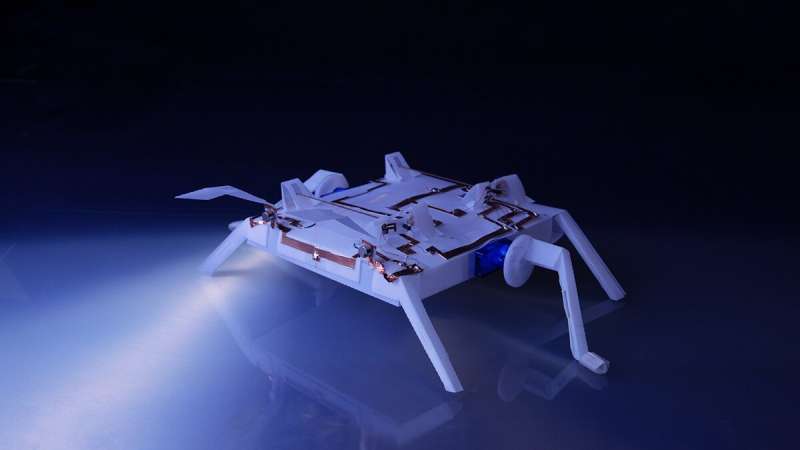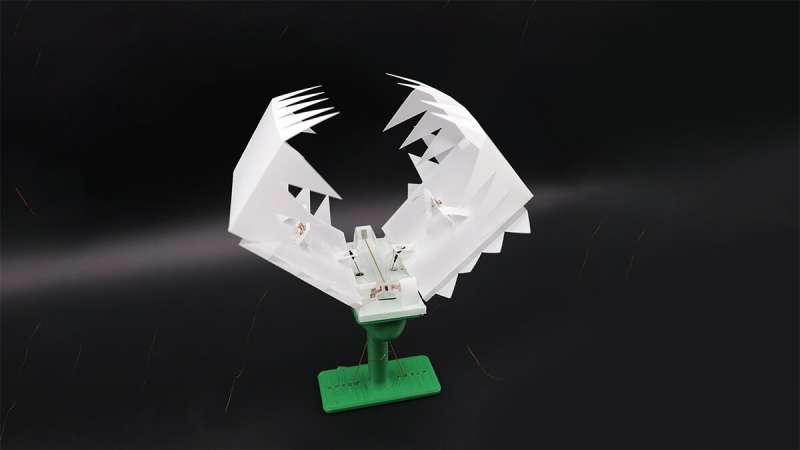This article has been reviewed according to Science X's editorial process and policies. Editors have highlighted the following attributes while ensuring the content's credibility:
fact-checked
peer-reviewed publication
trusted source
proofread
Origami-inspired robots can sense, analyze and act in challenging environments

Roboticists have been using a technique similar to the ancient art of paper folding to develop autonomous machines out of thin, flexible sheets. These lightweight robots are simpler and cheaper to make and more compact for easier storage and transport.
However, the rigid computer chips traditionally needed to enable advanced robot capabilities—sensing, analyzing and responding to the environment—add extra weight to the thin sheet materials and make them harder to fold. The semiconductor-based components must therefore be added after a robot has taken its final shape.
Now, a multidisciplinary team led by researchers at the UCLA Samueli School of Engineering has created a new fabrication technique for fully foldable robots that can perform a variety of complex tasks without relying on semiconductors. A study detailing the research findings was published in Nature Communications.
By embedding flexible and electrically conductive materials into a pre-cut, thin polyester film sheet, the researchers created a system of information-processing units, or transistors, that can be integrated with sensors and actuators. They then programmed the sheet with simple computer analogical functions that emulate those of semiconductors. Once cut, folded and assembled, the sheet transformed into an autonomous robot that can sense, analyze and act in response to their environments with precision. The researchers named their robots "OrigaMechs," short for Origami MechanoBots.
"This work leads to a new class of origami robots with expanded capabilities and levels of autonomy while maintaining the favorable attributes associated with origami folding-based fabrication," said study lead author Wenzhong Yan, a UCLA mechanical engineering doctoral student.
OrigaMechs derived their computing capabilities from a combination of mechanical origami multiplexed switches created by the folds and programmed Boolean logic commands, such as "AND," "OR" and "NOT." The switches enabled a mechanism that selectively output electrical signals based on the variable pressure and heat input into the system.
Using the new approach, the team built three robots to demonstrate the system's potential:
- an insect-like walking robot that reverses direction when either of its antennae senses an obstacle
- a Venus flytrap-like robot that envelops a "prey" when both of its jaw sensors detect an object
- a reprogrammable two-wheeled robot that can move along pre-designed paths of different geometric patterns

While the robots were tethered to a power source for the demonstration, the researchers said the long-term goal would be to outfit the autonomous origami robots with an embedded energy storage system powered by thin-film lithium batteries.
The chip-free design may lead to robots capable of working in extreme environments—strong radiative or magnetic fields, and places with intense radio frequency signals or high electrostatic discharges—where traditional semiconductor-based electronics might fail to function.
"These types of dangerous or unpredictable scenarios, such as during a natural or manmade disaster, could be where origami robots proved to be especially useful," said study principal investigator Ankur Mehta, an assistant professor of electrical and computer engineering and director of UCLA's Laboratory for Embedded Machines and Ubiquitous Robots.
"The robots could be designed for specialty functions and manufactured on demand very quickly," Mehta added. "Also, while it's a very long way away, there could be environments on other planets where explorer robots that are impervious to those scenarios would be very desirable."
Pre-assembled robots built by this flexible cut-and-fold technique could be transported in flat packaging for massive space savings. This is important in scenarios such as space missions, where every cubic centimeter counts. The low-cost, lightweight and simple-to-fabricate robots could also lead to innovative educational tools or new types of toys and games.
Other authors on the study are UCLA undergraduate student Mauricio Deguchi and graduate student Zhaoliang Zheng, as well as roboticists Shuguang Li and Daniela Rus from the Massachusetts Institute of Technology.
More information: Wenzhong Yan et al, Origami-based integration of robots that sense, decide, and respond, Nature Communications (2023). DOI: 10.1038/s41467-023-37158-9

















